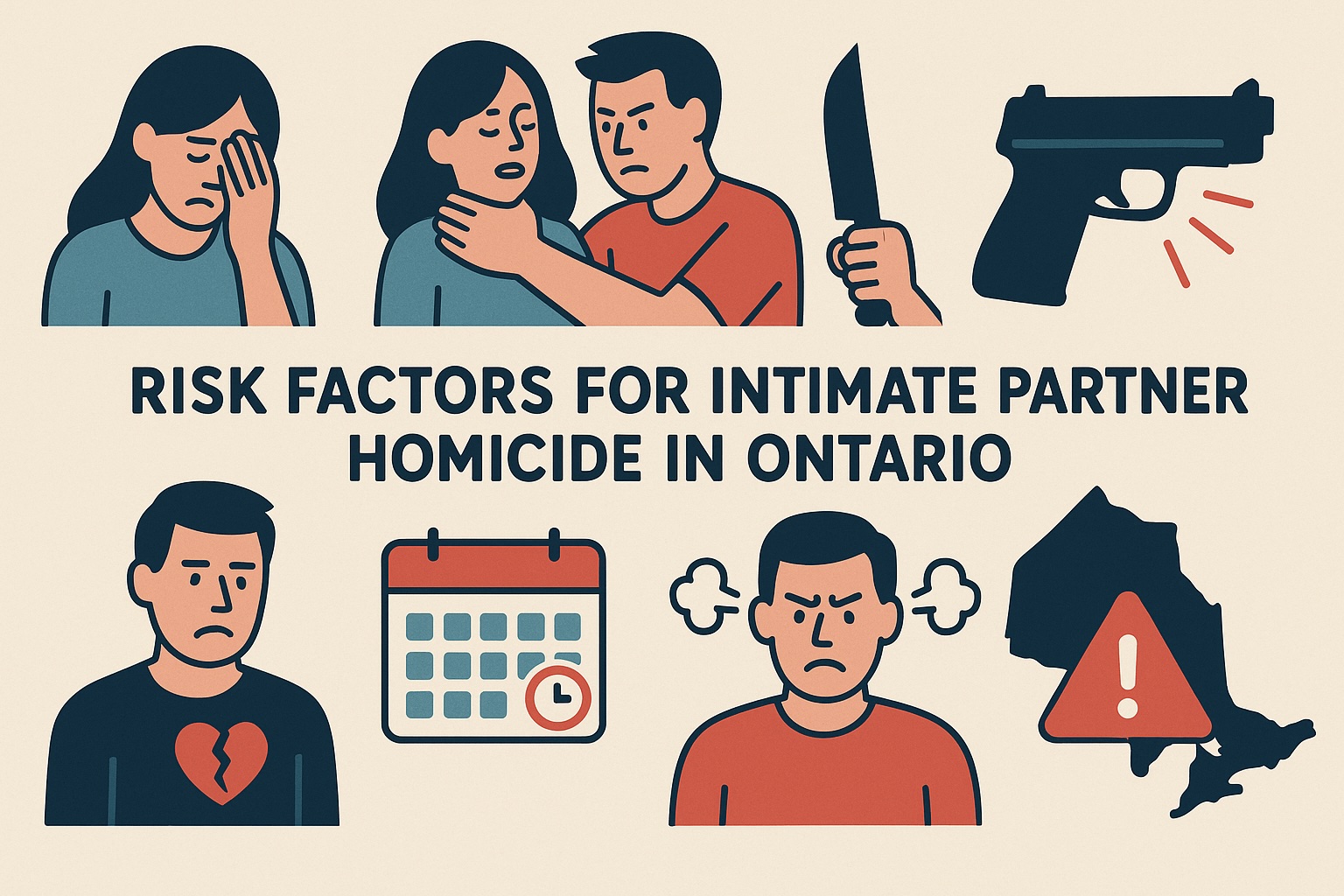Risk Factors for Intimate Partner Homicide in Ontario
Most domestic homicides are predictable—and preventable. Learn the top warning signs that signal extreme danger in abusive relationships in Ontario.

Every year in Ontario, dozens of women are killed by a current or former partner. These tragic deaths are rarely “out of the blue.” Research shows that **domestic homicides are often preceded by clear warning signs**.
This guide outlines the **key risk factors for intimate partner homicide**, based on Ontario’s Domestic Violence Death Review Committee (DVDRC) findings and global research.
***
### ⚠️ Why This Matters
* Recognizing these warning signs could **save a life**
* Risk escalates **after separation**, not before
* Friends, family, and service providers need to know what to look for
* Survivors often **underestimate how dangerous the situation is**
***
### 🔍 Top Risk Factors for Domestic Homicide
#### 🧨 High-Risk Relationship Dynamics
* **Prior threats to kill** the victim or themselves
* **Recent or pending separation** (especially within the last 6 months)
* **Obsessive jealousy or stalking**
* **Access to firearms or weapons**
* **Escalating violence or control**
* **History of strangulation** or choking
* **Victim has expressed fear** for their life
* **Abuser has harmed or killed pets**
* **Sexual violence or coercion** within the relationship
#### 🧠 Mental Health & Criminal History
* **Perpetrator has untreated mental illness** or substance use disorder
* **History of violence** toward others (including non-partners)
* **Criminal charges for domestic abuse** or breaches of restraining orders
* **Suicidal ideation or threats** (“If I can’t have you, no one will”)
#### 👪 Family Factors
* **Children are present** in the home or custody is in dispute
* **Victim is isolated** from friends/family
* **Increased financial dependence** on the abuser
* **Cultural or language barriers** preventing access to help
***
### 📈 Ontario Homicide Trends (Snapshot)
* Over **80% of domestic homicide victims are women**
* **Strangulation is a leading indicator** of potential lethal violence
* Many victims had **contact with police, courts, or healthcare** shortly before death
* In many cases, **friends or family suspected the danger—but didn’t know what to do**
> These patterns are not just statistics. They are red flags that demand urgent attention.
***
### 🛡️ What You Can Do
* Help the survivor create a **personal safety plan**
* Encourage contact with a **DV support agency or shelter**
* **Report threats or stalking** to police immediately
* Ask if the survivor feels scared or in danger—and believe them
* Share resources like the **Assaulted Women’s Helpline**
***
### 📌 Summary: Key Risk Factors
* ✅ Recent separation, threats to kill, and controlling behavior are major red flags
* ✅ Strangulation, access to weapons, and stalking increase homicide risk
* ✅ Suicidal abusers may become homicidal
* ✅ Victims often reach out for help shortly before lethal events
* ✅ Don’t ignore “gut feelings”—they may be right
***
### 📞 Where to Get Help or Report Concerns
* **Assaulted Women’s Helpline (24/7):** 1-866-863-0511
* **Ontario Provincial Police (OPP):** 1-888-310-1122
* **Local Victim Services** – via [211ontario.ca](https://211ontario.ca/)
* **Luke’s Place** – Legal advocacy for women in danger
* **Barbra Schlifer Commemorative Clinic** – Safety planning and legal help
***
### Frequently Asked Questions (FAQs)
#### 1. What is the single biggest warning sign for a domestic violence situation becoming lethal?
According to the Ontario Domestic Violence Death Review Committee, a history of domestic violence itself is the number one risk factor. The most dangerous time is often in the first six months after a survivor has separated from the abuser.
#### 2. My partner has choked me before, but didn't leave a mark. Is this a serious risk factor?
Yes, this is extremely serious. A history of non-fatal strangulation or choking is one of the most significant predictors of a future homicide. It is a terrifying display of control and demonstrates a capacity for lethal violence.
#### 3. The abuser has threatened to kill themselves if I leave. Is this a risk factor for me?
Yes, absolutely. An abuser's suicidal threats or ideation are strongly linked to the risk of intimate partner homicide-suicide. This is a form of manipulation and a major warning sign that the situation is high-risk.
#### 4. Are there specific legal steps I can take if I recognize these risk factors?
Yes. If you recognize these risk factors, it is critical to seek help immediately. You can contact the Assaulted Women's Helpline (1-866-863-0511) to create a safety plan. Legally, you should go to court to get an urgent restraining order and an order for exclusive possession of the home.
#### 5. What is the Ontario Domestic Violence Death Review Committee (DVDRC)?
The DVDRC is a committee of experts that analyzes domestic violence deaths in Ontario to identify common patterns and risk factors. Their goal is to make recommendations to prevent similar deaths from happening in the future. Their research is a crucial source of information for police, social workers, and legal professionals.
#### 6. Do these risk factors apply to all types of relationships?
Yes. While the majority of victims are women in relationships with men, these risk factors for lethal violence can apply to any intimate partner relationship, regardless of gender identity, sexual orientation, age, or cultural background.
